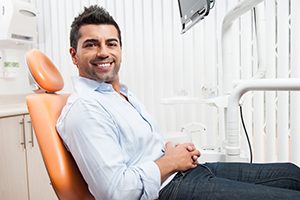Where Did All the Pain Go?
 The Reality is, Today’s Dentistry is Virtually Painless
The Reality is, Today’s Dentistry is Virtually Painless
There’s a bright new trend in dental offices these days: More people are making appointments because they want to, not because they have to.
What is it about a visit to the dentist that feels this good?
One simple, wonderful fact: In most cases, the pain is gone. Painless dental treatment is bringing us to a level of well-being—and appearance—makes a positive, tangible difference in our lives.
Dental medicine has come a long way.
The reality is, today’s dentistry is virtually painless. Technology, new procedures, and some very sophisticated approaches to anesthesia have all contributed to painless treatment—from cleaning to cavity preparation to root canal treatment.
New tools of the trade
The first dental handpiece (drill) was introduced in 1838, and for some time just did not improve. But in the last 30 years, the rotary drill has received considerable engineering attention. Now, the development of diamond points, tungsten carbide burs, and special ball bearings has given us ultra-high-speed tooth preparation—less pressure on teeth, more speed, less discomfort.
What else is new?
- Injection needles are smaller, more precise, more elegant, so dentists can isolate anesthesia down to a single tooth.
- Bonding and laminating materials have radically changed the thinking about cosmetic dentistry. Now the structure of the natural tooth may be retained and, in most cases, drilling and anesthesia are eliminated altogether.
- New materials for braces have accelerated and refined orthodontic treatment to a high degree.
So why the sweaty palms?
Dentistry has pain licked. So why is there the least hesitation to seek treatment?
It’s the fear of pain that still concerns dentists and, because of its psychological factors, it’s a thornier problem—the focus of much modern research.
Where does fear come from?
Dental fear comes from much misconception, memory, even the movies (when was the last time a film featured the hero’s benign, pleasant experience at the dentist’s office?).
Some people feel especially apprehensive by the close quarters required for dental care. Your mouth and face—key to self-expression—near where you perceive the center of your “self.” And getting that close can cause the jitters.
Whatever the reason, it’s clear that nervous people feel pain differently. Noted behavioral scientist Dr. Norman Corah, State University of New York, Buffalo School of Dentistry explains, “People who are anxious have a greater propensity to experience pain when there is no real reason for them to feel anything.”
By the same token, those who have no expectation of pain won’t feel it. While some people need the security of knowing nitrous oxide is there, some will settle for oil of ants!
The research continues: lasers, chemicals to “wash away” decay, even ways to harness endorphins—natural painkillers produced by the brain. It was never truer—day, in every way, dentistry gets better and better.
It wasn’t always so easy
In the early days of medicine, toothache treatment tested the limits of pain, not to mention the appetite. Some flavorful 17th century remedies called for dried viper lozenges, oil of ants, or donkey hoof (That these “cures” apparently worked is due to their placebo effect.) Whiskey was the anesthetic of choice.
![]()
About Yuri Kaneda, DDS
Dr. Yuri Kaneda was born in Japan and immigrated to the US when she was 4 years old with her family. She lived in Ohio, Nebraska, and Illinois before finally settling in the San Diego area. A graduate of Bonita Vista High School, she went on to the University of California Berkeley where she obtained her Bachelors in Microbiology and Immunology. After working for 2 years in growth plate research at University of California San Diego, she went to the University of California San Francisco Dental School for her Doctor of Dental Surgery degree. Upon graduation, she returned to San Diego where she worked as an associate in the practice of Drs. Morimoto and Yaryan, her childhood dentist. She then started her own practice in 1995 and has been at her present location since 1999 which happens to be across the street from her high school!
View all posts by Yuri Kaneda, DDS →
Appointments
To schedule an appointment please email us at [email protected].

